Prism Issue 9 | Winter 2023

Prism Issue 9, Winter 2023
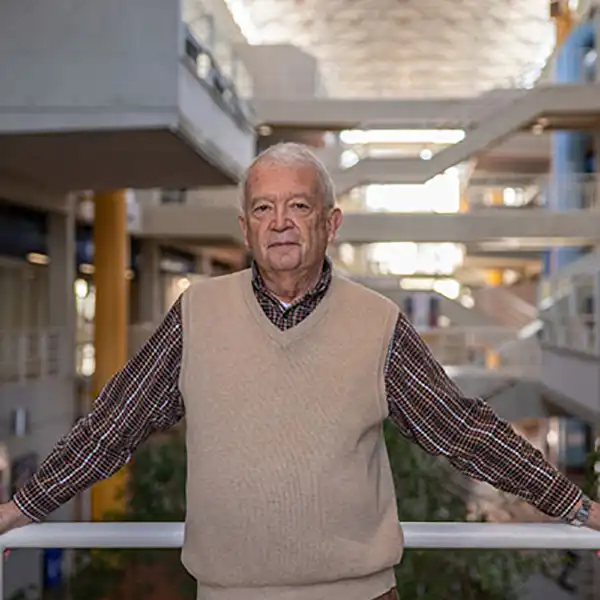
Leaving a Legacy: Sam Yates
In 1980, a young Sam Yates came to the University of Tennessee. A new Art and Architecture Building was being built and the Ewing Gallery was to become a prominent exhibition gallery on the campus of UT Knoxville. Sam Yates became the director of this gallery. Though an incredible curator of exhibits and an excellent program planner, Yates is also a teacher at heart. He gained his love of art in school and during his studies in art school in North Carolina where he studied painting as well many other areas of artistic expression. It was also during art school that he began to teach art.
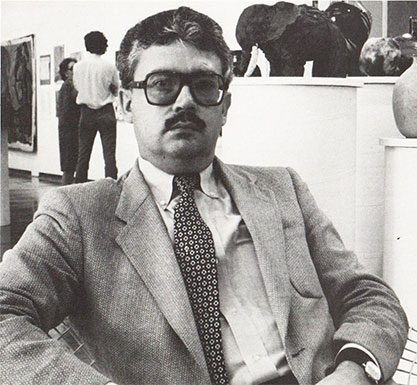
His excellence as a teacher was recognized quickly. That led to a teaching position at the University of Wisconsin, Oshkosh. During his years in Wisconsin, Yates began working with exhibitions. His responsibilities included working with students to plan both art and music shows. Exhibits, lectures, and shows brought him in contact with artists ranging from Buckminster Fuller to Al Capp, to Johnny Cash, to Fleetwood Mac. With this experience, Yates moved on to Northern Illinois University, DeKalb, where he worked full-time with their galleries, while teaching painting on the side.
Though he enjoyed his time in the northern Midwest, Yates and his wife determined that it was time to move nearer to their families in North Carolina, so when the opportunity to join the faculty at UT arose, he was ready to move to Knoxville. And here he has lived, taught, and directed the Ewing Gallery for over 40 years. In this community, he has worked on committees with the Knoxville Museum of Art. He has consulted on the design of small museums in Ducktown, Townsend, Etowah, and others. More than anything, however, he has touched the lives of students, faculty, staff, and community members through his knowledgeable ability to curate artistic exhibitions and to set up lecture series.
Sam Yates is looking forward to the opportunities that retirement will offer, hoping to travel to Berlin, Japan, Italy, and Ireland. He anticipates being able to spend time painting.
The UT School of Art hosted a retirement party for Sam Yates on April 24 at the Emporium Art Center, in order to recognize the enormous contributions that Yates has made to the School of Art over his years of service. At this event, the school publicly announced the establishment of a named endowment and the naming of Ewing Gallery’s Study Room in his honor. This fund is still receiving donations at: giving.utk.edu/yates
Contributions will be used to support the conservation, study, and exhibition of the Ewing Collection, and Ewing Gallery programming, which Yates was instrumental in developing over the course of his career at UT.

The retirement celebration featured in-person and recorded tributes to Sam Yates from former directors of the School of Art, colleagues and co-workers, former students, and friends. Their stories and statements pointed to the value that Yates brought to his work and the impact his life had on so many people across the decades.
Musing on his life’s task of curating and developing art exhibitions, Yates comments, “When you bring in an artist’s exhibit, students learn from that person. You may never know, but sometimes you do find out later, how that show really had a tremendous impact on a student’s life and work.”
Christopher McNulty, current director of the UT School of Art, bids farewell to Sam Yates, saying, “Please join us in thanking and recognizing Sam Yates for his immeasurable contributions to the School of Art over his 40 years of service. Thank you, Sam! Your curatorial vision, dedication, and mentorship have profoundly shaped and influenced generations of UT School of Art students. You will be greatly missed!”
Julie Lohnes: Director, Curator of Galleries and Collections
Julie C. Lohnes has joined the faculty and staff of the University of Tennessee School of Art as Director, Curator of Galleries and Collections.
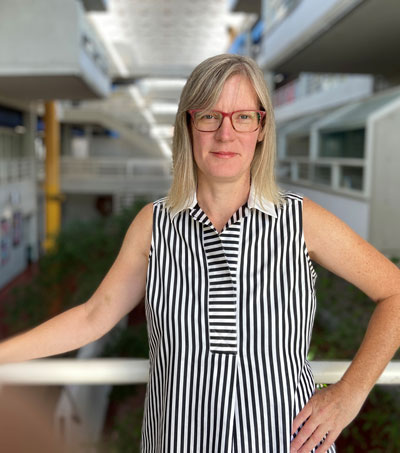
Before coming to the University of Tennessee School of Art, she was the Director and Curator of Art Collections and Exhibitions at Union College, in Schenectady, NY, where she managed the daily operations of four exhibition venues and cared for a collection of over 3,000 items. There, she helped to develop and implement the department’s vision while conceptualizing, planning, and implementing as many as five exhibitions each year.
Prior to her appointment at Union College, Lohnes was Executive Director of A.I.R. Gallery in Brooklyn, NY. There she produced over 30 exhibitions in an eleven-month season in collaboration with over 400 artists. A.I.R. Gallery seeks to champion women artists, increasing their visibility and the viability of their endeavors.
Julie Lohnes has an educational background that includes studio art in painting, video, sculpture, and installations, as well as studies in art history. Her work history has included executive leadership with for profit galleries, not-for-profit galleries, and educational institutions. Because Lohnes has a studio art background, she was quick to understand that trusting the artist is critical to planning and curating exhibitions. She says, “I love to see ideas percolating and the palpable energy artists bring to the exhibition environment. When curating exhibitions, I feel it is important to notice the subtleties of how art works speak to each other within the gallery as a whole. I am always seeking out artists that consider the visual arts and current issues, fusing content and formal qualities together.”
Coming to the University of Tennessee, the new director realizes that she can take advantage of a network of people who are aware of the reputation of the UT galleries. “It is great to be following in respected footsteps, as well as to be working with Sarah McFall and Eric Cagley who have both done such good work at the Ewing Gallery, and Mike Berry at the UT Downtown Gallery.”
Having grown up in the Washington D.C. and Maryland areas, Lohnes looks forward to reacquainting herself with the southeast area, its colleges, and its communities. She sees the arts as a soft way to build conversations and to bring communities together through the content of pieces in exhibitions.
Althea Murphy-Price, Printmaking Professor, Wins 2022 Jefferson Prize

The Jefferson Prize at the University of Tennessee is awarded to tenured or tenure-track faculty members who have demonstrated excellence in research and creative activity. This year the honor has been awarded to School of Art Printmaking Professor Althea Murphy-Price.
Murphy-Price came to UT in 2010, and has been part of the team of printmaking artists who have made Printmaking at the UT School of Art one of the top programs in the United States. Her contributions to teaching and scholarship include two Ellen Berry McClung Professorships in 2017 and 2021, a Chancellor’s Professional Development Award, a Senior Diversity Leadership Award, The Chancellor’s Research and Creative Achievement Award and Grant for Faculty Research.
Christopher McNulty, director of the UT School of Art, states, “Professor Murphy-Price’s tremendous research accomplishments, transformational mentorship of undergraduate and graduate students, and outstanding service contributions to the institution and profession make her an outstanding recipient of the Jefferson Award, providing important and meaningful recognition of the excellence in both her creative activity and many other previously underrecognized achievements.”
Her colleague, Beauvais Lyons was pleased by the news of Murphy-Price’s selection for the Jefferson Prize, saying, “Althea Murphy-Price is a wonderful colleague, and an inspirational artist, working with print media that combines traditional and new technologies to make art that is both beautiful and profound. Additionally, prospective graduate students apply to the University of Tennessee because she is a generous and supportive mentor.”
“It is incredible that Dr. Murphy-Price has won this award,” states MFA student Zoe Brester-Pennings, “because she is such an intelligent, kind, and generous human being.”
Murphy-Price has devoted much of her efforts to enhancing community experiences for underrepresented faculty and students. She serves as a Diversity Faculty Fellow in the College of Art and Sciences.
In addition to participating in a number of DEI initiatives, she has founded a a student exhibition exchange program with the HBCUs Fisk and Tennessee State University. This past Spring five students from Fisk, four from Tennessee State, and 12 from UT contributed to The Light of the Truth Exchange and its three exhibitions. Althea Murphy-Price and her co-organizers encouraged the students to respond artistically to the words of Ida B. Wells in an 1892 speech, “The way to right wrongs is to turn the light of truth upon them.”
The work of Murphy-Price in the classroom, galleries, the community, in our university, and in one-to-one mentoring make her uniquely deserving of the honor of being awarded the Jefferson Prize.
Happenings at the School of Art

Elaine McMillion Sheldon received a 2022 Silver Telly Award for her documentary film, Tutwiler, in the Television – Public Interest/Awareness category. She is director and producer of the film that was episode eight of the America ReFramed series, a co-production of the WORLD Channel and American Documentary, Inc. The ReFramed series curates a diverse selection of independent documentaries that brings to national audiences compelling stories that illuminate the changing contours of our ever-evolving country.
Presented in partnership with FRONTLINE and The Marshall Project, Tutwiler takes audiences into Alabama’s only maximum security women’s penitentiary, Julia Tutwiler Prison, and explores the Alabama Prison Birth Project, helping expectant and new mothers learn childbirth and parenting skills while dealing with the pain of being separated from their children.
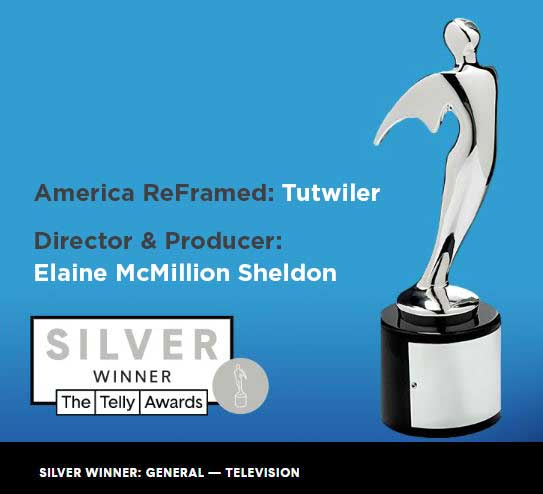
The Telly Awards is the premier award honoring video and television across all screens. Established in 1979, The Telly Awards receives over 12,000 entries from all 50 states and five continents.
Sheldon’s most recent full-length documentary, King Coal, was selected to premiere at the 2023 Sundance Film Festival. The film examines the cultural roots of coal that continue to permeate the rituals of daily life in Appalachia even as its economic power wanes.
*Elaine McMillion Sheldon is an assistant professor of Cinema Studies at UT School of Art. She lives in Knoxville, Tennessee with her husband and filmmaker, Curren Sheldon. Sheldon’s films can be viewed at elainemcmillionsheldon.com.
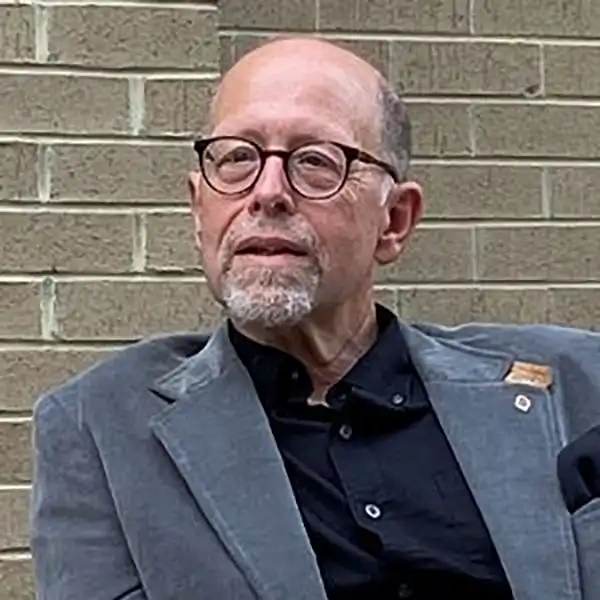
Frank R. Martin, long-time colleague and ceramics associate professor at the UT School of Art, has decided to leave academia and focus on his studio practice. The faculty and staff of the school celebrated with him in September, wishing him success as he looks forward to the opportunities that lie ahead. Martin has been named a Professor Emeritus.

Martin will be greatly missed for his teaching in the classroom, his support of students in the Pottery Club, as well as his active leadership in the annual UT School of Art High School Art Academy.
He states, “The focus of my work explores the possibility of going beyond the limits of utility. In my work, intent of function is vital and inescapable. My goal is to challenge the viewer’s notion of an object’s ‘use’, while assuring that the vessel performs flawlessly in its function and beautifully in its appearance.”
Martin’s work can be viewed at frankrmartin.com.
Chancellor’s Professor Beauvais Lyons Coordinates Symposium To Mark the 50th Anniversary of “The Civilization of Llhuros”

Beauvais Lyons is a Chancellor’s Professor at UT, where he has taught printmaking since 1985. Lyons describes his own work, saying, “For the past four decades I have created academic parody in a variety of mediums. For much of this time I fabricated and documented imaginary cultures. More recently I have been interested in biography, folk art, medicine, zoology and circuses. My lithographs are influenced by plates from old encyclopedias, the novellas of Jorge Luis Borges, 18th-century science, 19th-century printing, natural history museums. . .”
It is not surprising that Lyons coordinated an all-day virtual event, hosted by the UT School of Art to mark the 50th anniversary of Norman Daly’s “Civilization of Llhuros.” He and over 120 artists and scholars discussed this pioneering multimedia work of archaeological fiction which had its first exhibition at Cornell University in 1972.
Daly had decided to create an ancient civilization from scratch. In an article with The Conversation, Lyons explained, “To the casual viewer, Llhuros appeared to be real. The artifacts and tools were often made from found objects – an Ivory dish-soap bottle transformed into an earthenware figure, or a ‘nasal flute found at the early excavations at Lamplö’ made from a metal stove burner. Many of the objects were cracked and broken, with patinas and incrustations making them appear as if they’d survived centuries. The tension between real and fake was tangible.”
The symposium allowed a wide group of scholars from a range of disciplines to reinspect the origins of fictive art and to identify the value of this artistic genre in speaking to individuals of this generation who are constantly challenged to sort out truth from deception.
Lyons reflected, “When millions of people are persuaded by alternate facts or conspiracy theories, we need art that helps them to spot misinformation. Exhibits such as this, which give viewers the opportunity to recognize the tools of deception – have particular relevance today.”
Exchange Program with E. Geppert Academy of Art and Design in Wroclaw, Poland
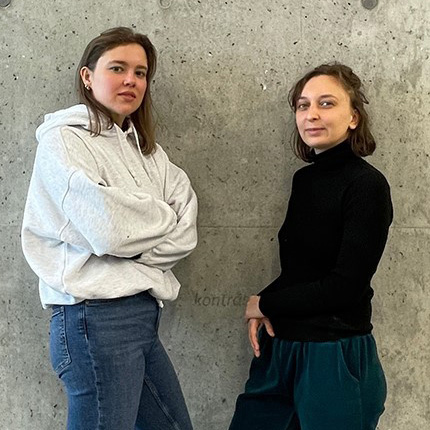
The UT School of Art welcomed Agnieszka Hoza and Izabela Kabza both of whom are graduate students in the MFA program in Wrocław, Poland, as resident-artists in the printmaking program in Knoxville. These printmakers, who arrived in Knoxville in the beginning September, presented an exhibition of their artwork entitled Micrographs/Planned Accidents at Gallery 1010 while in Knoxville.
For more than 15 years, the Printmaking Program in the UT School of Art has had an affiliation with the Graphics Department at the E. Geppert Academy of Art and Design in Wrocław, Poland, including an ongoing student exchange. The 2022 exchange, which had been postponed for two years due to COVID, allows two students from each program to spend a month as Artists-in-Residence at the other institution.
Through this arrangement two UT graduate students spent four weeks in Wrocław in May and June, and two students from Wroclaw came to Knoxville in September. The timing of the exchanges take place so that participating students do not miss any coursework during the regular academic calendar at their home university/academy.
In May, Muriel Condon, who had just completed her MFA degree, and second-year graduate student Noah Lagle travelled to Wrocław as part of the exchange. During their residency they worked in the academy studios, participating in classes, and presented an exhibition of their work.
Global History of Sport
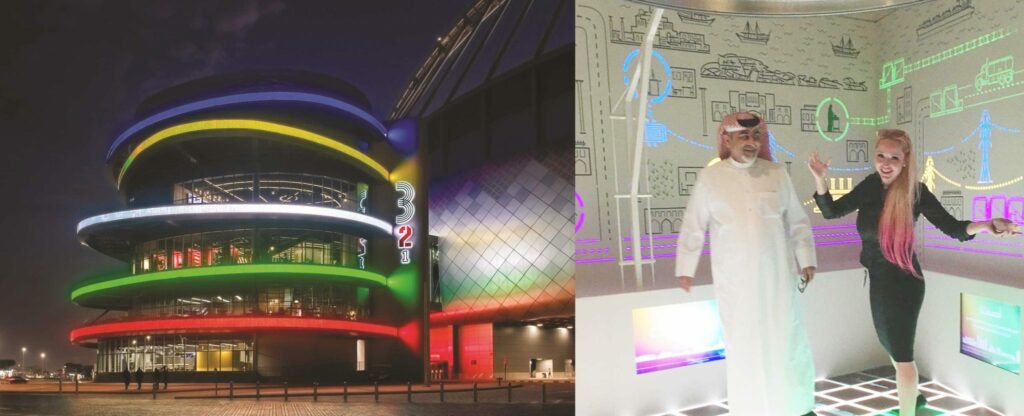
In April, 2022, Kelli Wood, assistant professor of Art History at the UT School of Art, received an email from Abdulla Yousuf Al Mulla, Director of the 3-2-1 Qatar Olympics and Sports Museum, reporting to her that the March 31 opening of the Museum was successful. He stated, “I would like to take this opportunity to thank you for all your hard work and dedication provided to the museum. Your Gallery is the entrance to the museum and it reflects the great research work.”
Kelli Wood had curated ‘Gallery 2 – A Global History of Sport,’ and was tasked with introducing museum visitors to humanity’s enduring cultures of athletics that span continents and centuries.

“Sport endures as one of the most significant cultural forces in the development of human civilization,” said Wood. One of her favorite quotes is by Pulitzer Prize winning historian Barbara Tuchman. “In a speech she gave to the National Endowment for the Humanities, Tuchman surmised with all seriousness that in mankind’s better moments the invention of the ball ranks with the invention of the wheel. And I thought how poignant, through competition and collaboration sports and games have remained a universal part of our shared experience, even when we are separated by oceans or centuries. Let’s tell that story, the inclusive history of sport.”
A Global History of Sport takes visitors on a journey across the continents to show how sport evolved across the globe in response to deep human needs related to hunting and defense, religion and ritual, trade and transportation, and community and culture. Each geographic region features local sports from different time periods in history, including ancient Roman chariot racing in Europe, the Kemari ball game in Asia, horseback archery in the Middle East, lacrosse in The Americas, and the kingdom of Benin’s court athletics in Africa. The gallery ends with a transition into the emergence of modern sport, with history rushing forward from a penny-farthing bicycle to a rare 1907 Norton motorcycle made in the same year as the first timed speed races.
The museum features the latest technological innovations, including touch-table educational games and interactives. The job of curator has evolved with new technologies. Wood selected and acquired nearly 100 objects in the gallery, but says that so much went into other aspects of the gallery. “Game development, film production, design, accessibility, visitor flow…as curator of A Global History of Sport I worked with an incredible creative team that brainstormed how to engage visitors through not only artifacts and graphics but also video games and films.” Some examples include a digital globe with interactive screens that welcome visitors to the history of sport across the globe, and a station with life-sized bows that lets visitors practice their hand at ancient archery through a game simulation. But more than education or entertainment these new technologies offer solutions for ethical issues in museums.
Rather than purchasing Mesoamerican artifacts Wood oversaw the creation of a replica of the stone ball hoop from Chichen Itza and Spartan female runner using 3D printing.
Architect Joan Sibina, renowned for the Gaudí Centre in Catalonia, designed the Qatar Olympic and Sports Museum to evoke the Olympic rings, and the spiraling building’s attachment to the Khalifa Stadium allows visitors to trek from soccer match to museum visit. The 2022 FIFA World Cup expected an estimated 1.5 million visitors from around the world, and Wood anticipated this audience through her art historical method and the concept of the gallery. The concept of A Global History of Sport and its seven circular subzones echoes Sibina’s architectural design. “Cultures across the globe tell their own stories of their past through the artworks and objects they produced, in a language more universal than Arabic or English, the visual.” The museum also features a state of the art research center that welcomes scholars in sports studies. It includes one of the most important finds of rare materials on the history of soccer, the first known team roster from the 16th century, which Wood helped the museum acquire.
Wood joined UT in 2019 as assistant professor of art history—museum and curatorial studies in the School of Art and her research centers on the material and visual culture of sports and games. She now incorporates her experience as a curator into her teaching and students can take courses in the new museum & curatorial studies minor.
Crystal Wagner Receives UT Alumni Promise Award
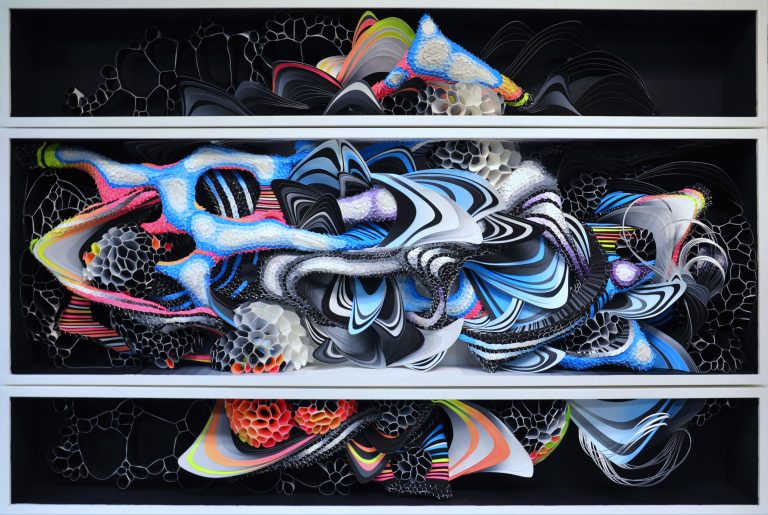
Artist and alumna, Crystal Wagner, received the UT Alumni Promise Award from the UT Alumni Association on Friday, September 16, 2022.
Wagner is a 2008 graduate from our #3 ranked MFA program in studio art with a concentration in printmaking, and has already established herself as a significant artist with recognition of her work through major exhibitions and commissions both in the United States and abroad.

Based in Los Angeles, Wagner is known for her artistic integration of two- and three-dimensional forms, alternative use of materials, and hybrid approaches to printmaking, to create large-scale site-specific installations. Notable commissions include an installation for the internationally recognized band, The Flaming Lips; a large shadow box for GNU a snowboard company based in Portland, Oregon; a large-scale installation piece for NIKE, presented in the Shrine Auditorium for The KOBE X Blackout Experience; and two installations for Viacom, one of which is a 117-foot piece at their headquarters in Times Square. In 2019 she created a site-specific work on the facade of Belcastel in Aveyron, France.
More recent projects include a large-scale installation for TOYOTA, and a new large-scale installation for her exhibition titled “Sublime” which opened at Fort Works Art, in Fort Worth, TX on July 9th and remained on view through October. Currently her work is featured in the Urban Art Biennale in Berlin, Germany.
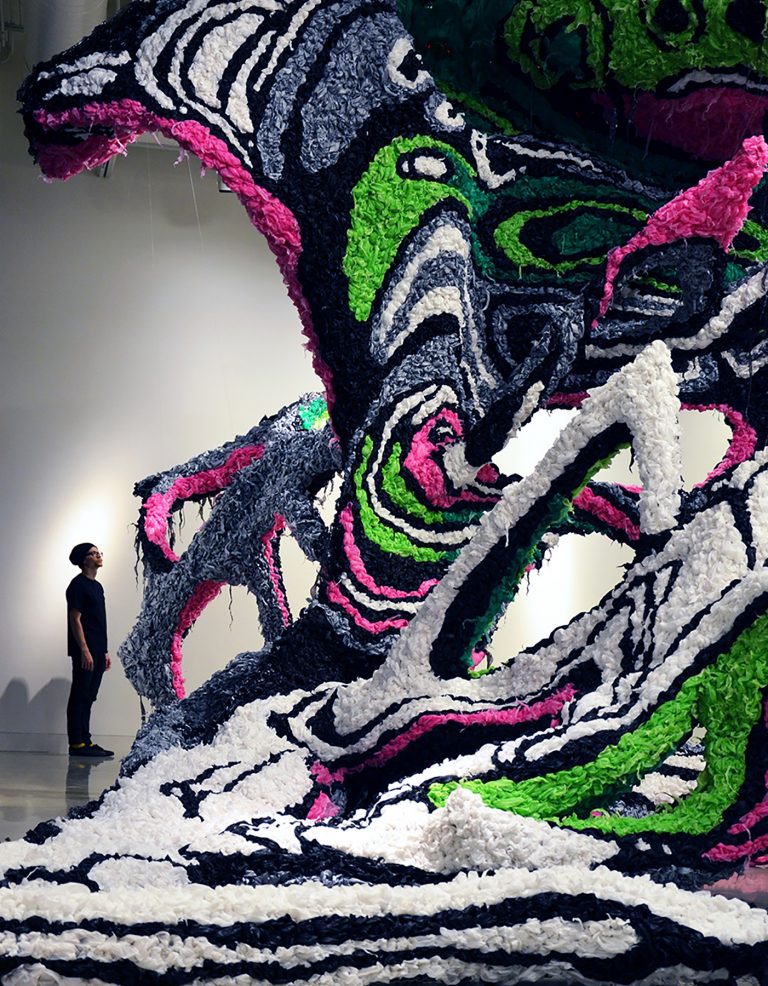
Wagner’s work has been featured in The New York Times, Architectural Digest, Artnet, Hi Fructose, Juxtapoze Magazine, Art & Science Journal, Complex Art & Design Magazine, Graffiti Art Magazine, and many more. She was the recipient of an Awesome Without Borders, Awesome Foundation Art Grant and the Sculpture and Installation Category Award Winner of the SEE.ME, Art Takes Paris, international art competition. In 2015, she was awarded a highly coveted Pollock-Krasner Grant. In 2019 Wagner was a recipient of the UT College of Arts and Sciences Divisional Achievement in Visual or Performing Arts Award.
Art & Object Magazine recently described her work as audaciously creative, “Made of torn plastic birthday party tablecloths stuffed into the openings of chicken wire fencing, these exuberant, boldly colored forms have a robust, eye-popping appeal.”
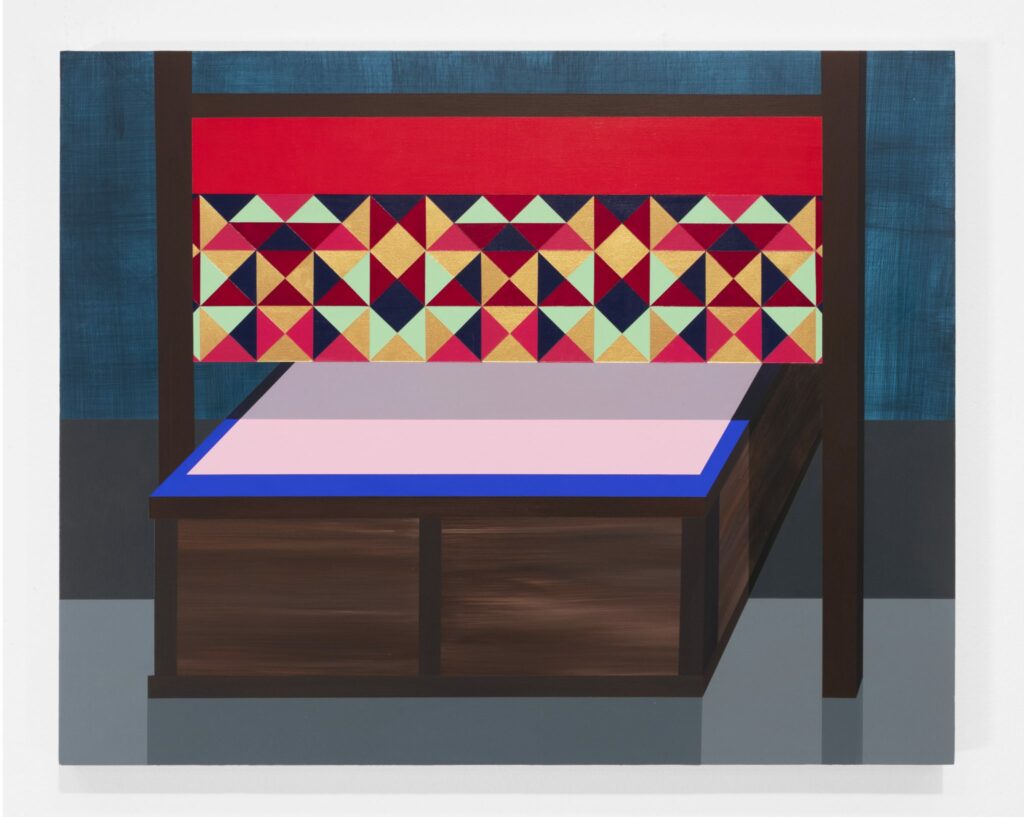
While her professional record of exhibitions and commissions is notable, anyone who sees her work can appreciate its sheer beauty and invention. The ability of the arts to enrich our lives is evident in her labors.
Faculty Artwork: Constellation by Mary Laube
Support the School of Art
We encourage you to be involved in the creative successes of the students and faculty of the School of Art. We rely on donors to provide critical support for scholarships, awards, and creative activity. Please consider making either a one-time or sustained contribution to one of our established funds.
art.utk.edu/support 865-974-3407